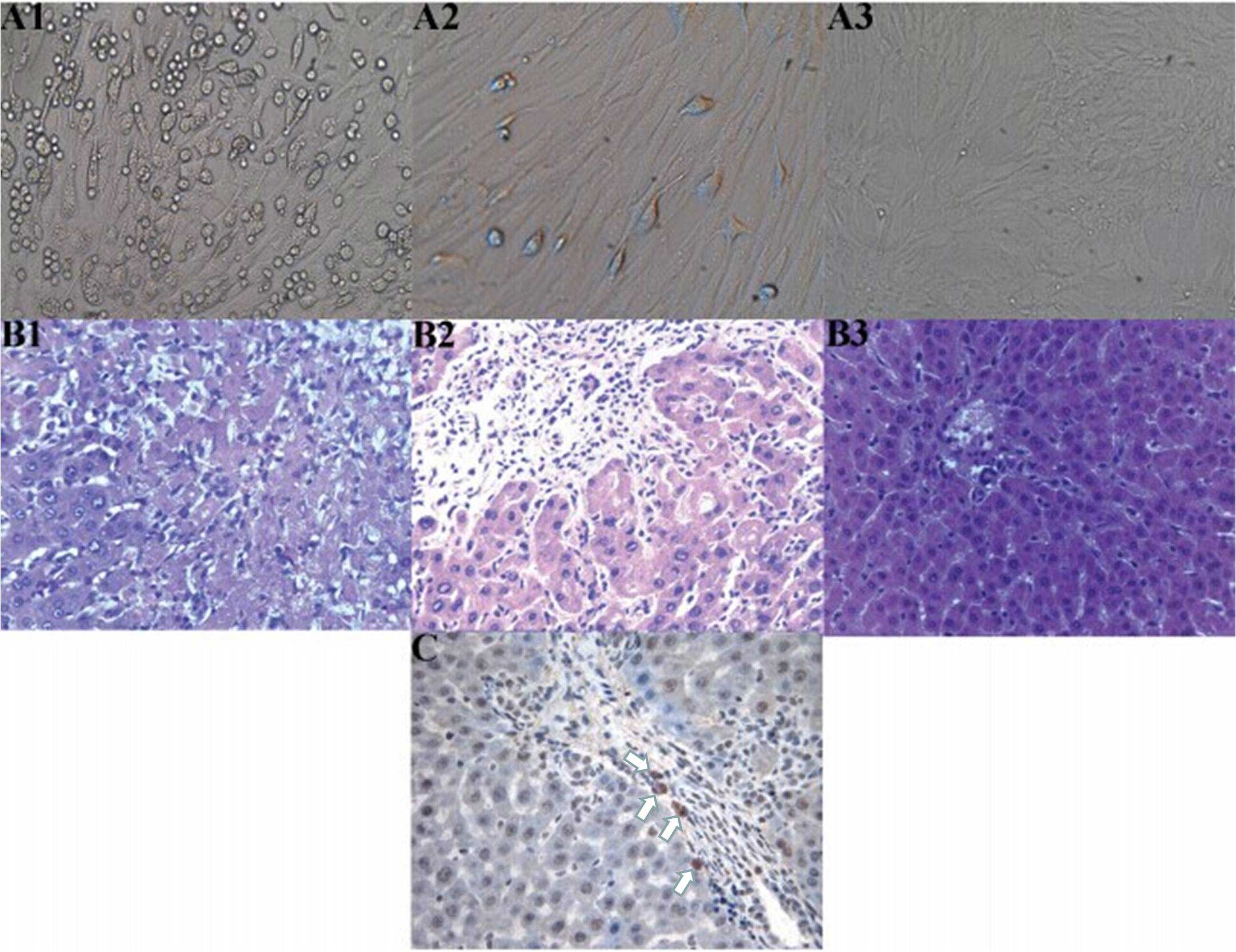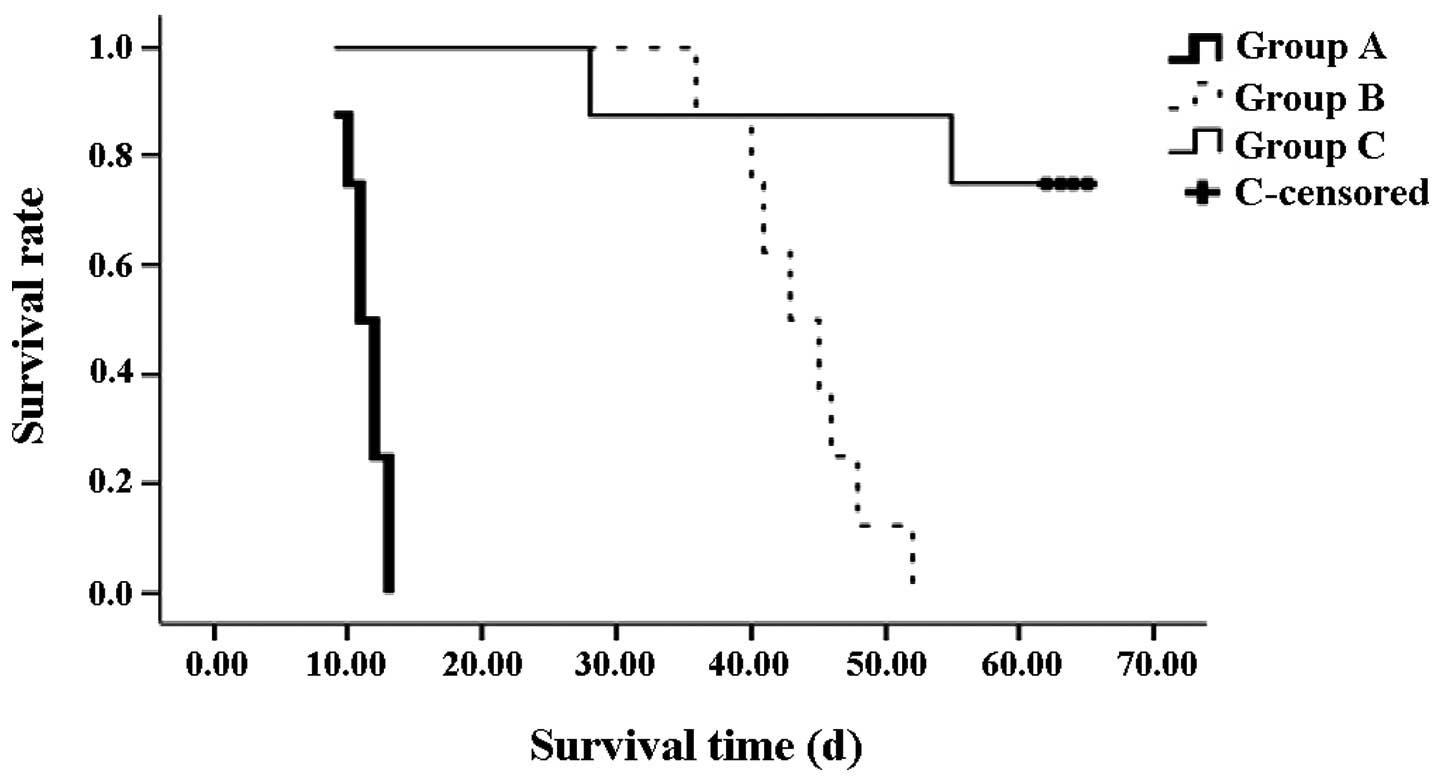|
1
|
Starzl TE, Marchioro TL, Faris TD, Carey
TA and Otte JB: The therapeutic potential of whole organ
transplantation. J Am Med Womens Assoc. 21:207–209. 1966.PubMed/NCBI
|
|
2
|
Bozbas SS, Eyuboglu FO, Ozturk Ergur F,
Gullu Arslan N, Sevmis S, Karakayali H, et al: Pulmonary
complications and mortality after liver transplant. Exp Clin
Transplant. 6:264–270. 2008.PubMed/NCBI
|
|
3
|
Tanaka T, Takatsuki M, Soyama A, Torashima
Y, Kinoshita A, Yamaguchi I, et al: Evaluation of immune function
under conversion from Prograf to Advagraf in living donor liver
transplantation. Ann Transplant. 18:293–298. 2013. View Article : Google Scholar : PubMed/NCBI
|
|
4
|
Bogdanos DP, Gao B and Gershwin ME: Liver
immunology. Compr Physiol. 3:567–598. 2013.PubMed/NCBI
|
|
5
|
Gerlach UA, Vogt K, Schlickeiser S, Meisel
C, Streitz M, Kunkel D, et al: Elevation of CD4+
differentiated memory T cells is associated with acute cellular and
antibody-mediated rejection after liver transplantation.
Transplantation. 95:1512–1520. 2013. View Article : Google Scholar : PubMed/NCBI
|
|
6
|
Di Nicola M, Carlo-Stella C, Magni M,
Milanesi M, Longoni PD, Matteucci P, et al: Human bone marrow
stromal cells suppress T-lymphocyte proliferation induced by
cellular or nonspecific mitogeni stimuli. Blood. 99:3838–3843.
2002. View Article : Google Scholar : PubMed/NCBI
|
|
7
|
Rasmusson I, Ringdén O, Sundberg B and Le
Blanc K: Mesenchymal stem cells inhibit the formation of cytotoxic
T lymphocytes, but not activated cytotoxic T lymphocytes or natural
killer cells. Transplantation. 76:1208–1213. 2003. View Article : Google Scholar : PubMed/NCBI
|
|
8
|
Le Blanc K, Rasmusson I, Götherström C,
Seidel C, Sundberg B, Sundin M, et al: Mesenchymal stem cells
inhibit the expression of CD25 (interleukin-2 receptor) and CD38 on
phytohaemagglutinin-activated lymphocytes. Scand J Immunol.
60:307–315. 2004. View Article : Google Scholar : PubMed/NCBI
|
|
9
|
Beyth S, Borovsky Z, Mevorach D,
Liebergall M, Gazit Z, Aslan H, et al: Human mesenchymal stem cells
alter antigen-presenting cell maturation and induce T-cell
unresponsiveness. Blood. 105:2214–2219. 2005. View Article : Google Scholar : PubMed/NCBI
|
|
10
|
Wood KJ, Bushell A and Hester J:
Regulatory immune cells in transplantation. Nat Rev Immunol.
12:417–430. 2012. View
Article : Google Scholar : PubMed/NCBI
|
|
11
|
English K, Ryan JM, Tobin L, Murphy MJ,
Barry FP and Mahon BP: Cell contact, prostaglandin E(2) and
transforming growth factor beta 1 play non-redundant roles in human
mesenchymal stem cell induction of CD4+CD25(High) forkhead box P3+
regulatory T cells. Clin Exp Immunol. 156:149–160. 2009. View Article : Google Scholar : PubMed/NCBI
|
|
12
|
Kordelas L, Rebmann V, Ludwig AK, Radtke
S, Ruesing J, Doeppner TR, et al: MSC-derived exosomes: a novel
tool to treat therapy-refractory graft-versus-host disease.
Leukemia. 28:970–973. 2014.PubMed/NCBI
|
|
13
|
Pittenger MF, Mackay AM, Beck SC, Jaiswal
RK, Douglas R, Mosca JD, et al: Multilineage potential of adult
human mesenchymal stem cells. Science. 284:143–147. 1999.
View Article : Google Scholar : PubMed/NCBI
|
|
14
|
Minguell JJ, Erices A and Conget P:
Mesenchymal stem cells. Exp Biol Med (Maywood). 226:507–520.
2001.PubMed/NCBI
|
|
15
|
Kamada N and Calne RY: A surgical
experience with five hundred thirty liver transplants in the rat.
Surgery. 93:64–69. 1983.PubMed/NCBI
|
|
16
|
Wei F, Wang TZ, Zhang J, Yuan ZY, Tian HY,
Ni YJ, et al: Mesenchymal stem cells neither fully acquire the
electrophysiological properties of mature cardiomyocytes nor
promote ventricular arrhythmias in infarcted rats. Basic Res
Cardiol. 107:2742012. View Article : Google Scholar : PubMed/NCBI
|
|
17
|
Williams JW, Peters TG, Vera SR, Britt LG,
van Voorst SJ and Haggitt RC: Biopsy-directed immunosuppression
following hepatic transplantation in man. Transplantation.
39:589–596. 1985. View Article : Google Scholar : PubMed/NCBI
|
|
18
|
Kojc N, Zidar N, Vodopivec B and Gale N:
Expression of CD34, alpha-smooth muscle actin, and transforming
growth factor beta1 in squamous intraepithelial lesions and
squamous cell carcinoma of the larynx and hypopharynx. Hum Pathol.
36:16–21. 2005. View Article : Google Scholar : PubMed/NCBI
|
|
19
|
Yi T and Song SU: Immunomodulatory
properties of mesenchymal stem cells and their therapeutic
applications. Arch Pharm Res. 35:213–221. 2012. View Article : Google Scholar : PubMed/NCBI
|
|
20
|
Kim YH, Wee YM, Choi MY, Lim DG, Kim SC
and Han DJ: Interleukin (IL)-10 induced by CD11b(+) cells and
IL-10-activated regulatory T cells play a role in immune modulation
of mesenchymal stem cells in rat islet allografts. Mol Med.
17:697–708. 2011. View Article : Google Scholar : PubMed/NCBI
|
|
21
|
Hong ZF, Huang XJ and Yin ZY:
Immunocharacteristics of bone marrow mesenchymal stem cell.
Zhonghua Gan Zang Bing Za Zhi. 17:53–58. 2009.(In Chinese).
PubMed/NCBI
|
|
22
|
Bartholomew A, Sturgeon C, Siatskas M,
Ferrer K, McIntosh K, Patil S, et al: Mesenchymal stem cells
suppress lymphocyte proliferation in vitro and prolong skin graft
survival in vivo. Exp Hematol. 30:42–48. 2002. View Article : Google Scholar : PubMed/NCBI
|
|
23
|
Schatton T, Yang J, Chandraker A, Sayegh
MH and Frank MH: In vivo immunomodulatory function of
ABCB5+ dermal mesenchymal stem cells. Transplantation.
82:185–186. 2006. View Article : Google Scholar
|
|
24
|
Pan MX, Hou WL, Zhang QJ, Gong DH, Cheng
Y, Jian GD and Gao Y: Infusion of autologous mesenchymal stem cells
prolongs the survival of dogs receiving living donor liver
transplantation. Nan Fang Yi Ke Da Xue Xue Bao. 29:1783–1786.
2009.(In Chinese). PubMed/NCBI
|
|
25
|
Zhang LS, Liu QF, Huang K, Zhang Y, Fan ZP
and Huang SL: Mesenchymal stem cells for treatment of
steroid-resistant chronic graft-versus-host disease. Zhonghua Nei
Ke Za Zhi. 48:542–546. 2009.(In Chinese). PubMed/NCBI
|
|
26
|
Colter DC, Class R, DiGirolamo CM and
Prockop DJ: Rapid expansion of recycling stem cells in cultures of
plastic-adherent cells from human bone marrow. Proc Natl Acad Sci
USA. 97:3213–3218. 2000. View Article : Google Scholar : PubMed/NCBI
|
|
27
|
Jiang Y, Jahagirda BN, Reinhardt RL,
Schwartz RE, Keene CD, Ortiz-Gonzalez XR, et al: Pluripotency of
mesenchymal stem cells derived from adult marrow. Nature.
418:41–49. 2002. View Article : Google Scholar : PubMed/NCBI
|
|
28
|
Ye Z, Wang Y, Xie HY and Zheng SS:
Immunosuppressive effects of rat mesenchymal stem cells:
involvement of CD4+CD25+ regulatory T cells.
Hepatobiliary Pancreat Dis Int. 7:608–614. 2008.PubMed/NCBI
|
|
29
|
Sekiya I, Larson BL, Smith JR, Pochampally
R, Cui JG and Prockop DJ: Expansion of human adult stem cells from
bone marrow stroma: conditions that maximize the yields of early
progenitors and evaluate their quality. Stem Cells. 20:530–541.
2002. View Article : Google Scholar : PubMed/NCBI
|
|
30
|
Xia X, Chen W, Ma T, Xu G, Liu H, Liang C,
et al: Mesenchymal stem cells administered after liver
transplantation prevent acute graft-versus-host disease in rats.
Liver Transpl. 18:696–706. 2012. View
Article : Google Scholar : PubMed/NCBI
|
|
31
|
Krampera M, Glennie S, Dyson J, Scott D,
Laylor R, Simpson E, et al: Bone marrow mesenchymal stem cells
inhibit the response of naive and memory antigen-specific T cells
to their cognate peptide. Blood. 101:3722–3729. 2003. View Article : Google Scholar : PubMed/NCBI
|
|
32
|
Popp FC, Renner P, Eggenhofer E, Slowik P,
Geissler EK, Piso P, et al: Mesenchymal stem cells as
immunomodulators after liver transplantation. Liver Transpl.
15:1192–1198. 2009. View
Article : Google Scholar : PubMed/NCBI
|
|
33
|
Di Nicola M, Carlo-Stella C, Magni M,
Milanesi M, Longoni PD, Matteucci P, et al: Human bone marrow
stromal cells suppress T-lymphocyte proliferation induced by
cellular or nonspecific mitogenic stimuli. Blood. 99:3838–3843.
2002. View Article : Google Scholar : PubMed/NCBI
|
|
34
|
Tobin LM, Healy ME, English K and Mahon
BP: Human mesenchymal stem cells suppress donor CD4(+) T cell
proliferation and reduce pathology in a humanized mouse model of
acute graft-versus-host disease. Clin Exp Immunol. 172:333–348.
2013. View Article : Google Scholar : PubMed/NCBI
|
|
35
|
Meisel R, Zibert A, Laryea M, Göbel U,
Däubener W and Dilloo D: Human bone marrow stromal cells inhibit
allogeneic T-cell responses by indoleamine 2,3-dioxygenase-mediated
tryptophan degradation. Blood. 103:4619–4621. 2004. View Article : Google Scholar : PubMed/NCBI
|
|
36
|
Niu J, Yue W, Song Y, Zhang Y, Qi X, Wang
Z, et al: Prevention of acute liver allograft rejection by
IL-10-engineered mesenchymal stem cells. Clin Exp Immunol.
176:473–484. 2014. View Article : Google Scholar : PubMed/NCBI
|
|
37
|
Han J, Zhao J, Xu J and Wen Y: Mesenchymal
stem cells genetically modified by lentivirus-mediated
interleukin-12 inhibit malignant ascites in mice. Exp Ther Med.
8:1330–1334. 2014.PubMed/NCBI
|
|
38
|
Aggarwal S and Pittenger MF: Human
mesenchymal stem cells modulate allogeneic immune cell responses.
Blood. 105:1815–1822. 2005. View Article : Google Scholar : PubMed/NCBI
|
|
39
|
Jiang XX, Zhang Y, Liu B, Zhang SX, Wu Y,
Yu XD and Mao N: Human mesenchymal stem cells inhibit
differentiation and function of monocyte-derived dendritic cells.
Blood. 105:4120–4126. 2005. View Article : Google Scholar : PubMed/NCBI
|
|
40
|
Pan GZ, Yang Y, Zhang J, Liu W, Wang GY,
Zhang YC, et al: Bone marrow mesenchymal stem cells ameliorate
hepatic ischemia/reperfusion injuries via inactivation of the
MEK/ERK signaling pathway in rats. J Surg Res. 178:935–948. 2012.
View Article : Google Scholar : PubMed/NCBI
|
|
41
|
Kuroda Y, Kitada M, Wakao S and Dezawa M:
Bone marrow mesenchymal cells: how do they contribute to tissue
repair and are they really stem cells. Arch Immunol Ther Exp
(Warsz). 59:369–378. 2011. View Article : Google Scholar : PubMed/NCBI
|
|
42
|
Pournasr B, Mohamadnejad M, Bagheri M,
Aghdami N, Shahsavani M, Malekzadeh R and Baharvand H: In vitro
differentiation of human bone marrow mesenchymal stem cells into
hepatocyte-like cells. Arch Iran Med. 14:244–249. 2011.PubMed/NCBI
|
|
43
|
Secchiero P, Corallini F, Zavan B, Tripodo
C, Vindigni V and Zauli G: Mesenchymal stem cells display
hepato-protective activity in lymphoma bearing xenografts. Invest
New Drugs. 30:803–807. 2012. View Article : Google Scholar : PubMed/NCBI
|
















